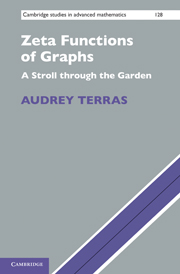
-
Select format
-
- Publisher:
- Cambridge University Press
- Publication date:
- 05 March 2013
- 18 November 2010
- ISBN:
- 9780511760426
- 9780521113670
- Dimensions:
- (228 x 152 mm)
- Weight & Pages:
- 0.53kg, 252 Pages
- Dimensions:
- Weight & Pages:
You may already have access via personal or institutional login
Book description
Graph theory meets number theory in this stimulating book. Ihara zeta functions of finite graphs are reciprocals of polynomials, sometimes in several variables. Analogies abound with number-theoretic functions such as Riemann/Dedekind zeta functions. For example, there is a Riemann hypothesis (which may be false) and prime number theorem for graphs. Explicit constructions of graph coverings use Galois theory to generalize Cayley and Schreier graphs. Then non-isomorphic simple graphs with the same zeta are produced, showing you cannot hear the shape of a graph. The spectra of matrices such as the adjacency and edge adjacency matrices of a graph are essential to the plot of this book, which makes connections with quantum chaos and random matrix theory, plus expander/Ramanujan graphs of interest in computer science. Created for beginning graduate students, the book will also appeal to researchers. Many well-chosen illustrations and exercises, both theoretical and computer-based, are included throughout.
Reviews
'The book is very appealing through its informal style and the variety of topics covered and may be considered the standard reference book in this field.'
Source: Zentralblatt MATH
Contents
Metrics
Altmetric attention score
Full text views
Full text views help Loading metrics...
Loading metrics...
* Views captured on Cambridge Core between #date#. This data will be updated every 24 hours.
Usage data cannot currently be displayed.
Accessibility standard: Unknown
Why this information is here
This section outlines the accessibility features of this content - including support for screen readers, full keyboard navigation and high-contrast display options. This may not be relevant for you.
Accessibility Information
Accessibility compliance for the PDF of this book is currently unknown and may be updated in the future.


